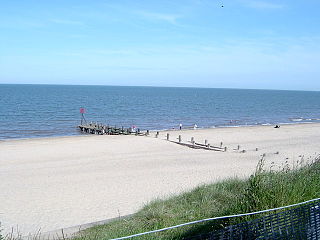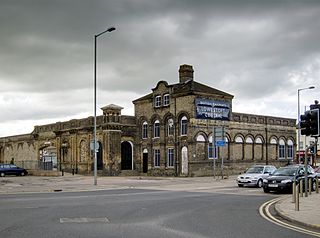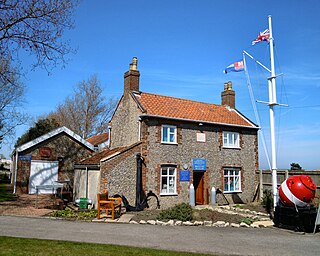
East Anglia is an area in the East of England, often defined as including the counties of Norfolk, Suffolk and Cambridgeshire. The name derives from the Anglo-Saxon kingdom of the East Angles, a people whose name originated in Anglia, in what is now Northern Germany.

Lowestoft is a coastal town and civil parish in the East Suffolk district of Suffolk, England. As the most easterly UK settlement, it is 110 miles (177 km) north-east of London, 38 miles (61 km) north-east of Ipswich and 22 miles (35 km) south-east of Norwich, and the main town in its district. The estimated population in the built-up area exceeds 70,000. Its development grew with the fishing industry and as a seaside resort with wide sandy beaches. As fishing declined, oil and gas exploitation in the North Sea in the 1960s took over. While these too have declined, Lowestoft is becoming a regional centre of the renewable energy industry.

Somerleyton is a village and former civil parish in the north of the English county of Suffolk. It is 4.5 miles (7.2 km) north-west of Lowestoft and 5.5 miles (8.9 km) south-west of Great Yarmouth in the East Suffolk district. The village is closely associated with Somerleyton Hall and was largely rebuilt as a model village in the 19th century at the direction of Samuel Morton Peto. The parish was combined with Herringfleet and Ashby to create the parish of Somerleyton, Ashby and Herringfleet in 1987.

Hopton-on-Sea is a village, civil parish and seaside resort on the coast of East Anglia in the county of Norfolk. The village is 4 miles (6.4 km) south of Great Yarmouth, 4+1⁄2 miles (7.2 km) north-west of Lowestoft and near the UK's most easterly point, Lowestoft Ness.

Lowestoft railway station serves the town of Lowestoft, Suffolk. It is the eastern terminus of the East Suffolk Line from Ipswich and is one of two eastern termini of the Wherry Lines from Norwich. Lowestoft is 23 miles 41 chains (37.8 km) down the line from Norwich and 48 miles 75 chains (78.8 km) measured from Ipswich; it is the easternmost station on the National Rail network in the United Kingdom.
The University of Suffolk is a public university situated in Suffolk and Norfolk, England. The modern university was established in 2007 as University Campus Suffolk (UCS), the institution was founded as a unique collaboration between the University of East Anglia and the University of Essex. The university's current name was adopted after it was granted independence in 2016 by the Privy Council and was awarded university status.
Ormiston Denes Academy is a secondary school with academy status located in the northern outskirts of Lowestoft in the English county of Suffolk. It has around 1000 students aged 11 to 16.
HMS D5 was one of eight D-class submarines built for the Royal Navy during the first decade of the 20th century.
Peterborough College, established in 1946 as Peterborough Technical College, is a major further education college in Peterborough, Cambridgeshire, United Kingdom.
Warsash Maritime School, formerly Warsash Maritime Centre and Warsash Maritime Academy, is a maritime training college that is part of Solent University. The college provides education, training, consultancy and research to the international shipping and off-shore oil industries. It is one of the United Kingdom's colleges responsible for the training of the British Merchant Navy. The courses on offer cover a wide range of maritime education and training from deck and engineer officer cadetships, including degree pathways, to senior officer certificates of competency, together with the associated safety training.

Lowestoft North railway station was in Lowestoft, England. It closed in 1970.

Yarmouth South Town, sometimes known as Yarmouth Southtown, was a railway station in Great Yarmouth, England, that is now closed. It was one of three major stations in the town, the others being Yarmouth Vauxhall and Yarmouth Beach, of which only Yarmouth Vauxhall now remains.

The College of Haringey, Enfield and North East London (CONEL) is a college of further and higher education in North London, England. The current college was founded in 2009 as a result of a merger between Enfield College and The College of North East London (Conel). The college has centres in Tottenham and Enfield and draws its students mainly from the boroughs of Haringey, Enfield, and Hackney, Since 2017 the college is a part of Capital City College Group (CCCG) alongside City and Islington College and Westminster Kingsway College.

Lound is a village and civil parish in the north of the English county of Suffolk. It is 4.5 miles (7.2 km) north of Lowestoft, 5 miles (8.0 km) south of Great Yarmouth in the East Suffolk district. It is 2 miles (3.2 km) from the North Sea coast at Hopton-on-Sea and is on the border with the county of Norfolk.

Highbury College is a further education college in Portsmouth, Hampshire, England. It offers vocational and academic education and training, including apprenticeships, A-levels and foundation degrees.

The Port of Lowestoft is a harbour in Lowestoft in the English county of Suffolk owned by Associated British Ports. It is the most easterly harbour in the United Kingdom and has direct sea access to the North Sea. The harbour is made up of two sections divided by a bascule bridge. The inner harbour is formed by Lake Lothing whilst the outer harbour is constructed from breakwaters.
The Yarmouth–Lowestoft line was an East Anglian railway line which linked the coastal towns of Yarmouth, Gorleston-on-Sea and Lowestoft. It opened on 13 July 1903 as the first direct railway link between the two towns and was constructed by the Great Eastern Railway and the Midland and Great Northern Railway in the hope of encouraging the development of holiday resorts along the coast. In the event, although the line was built to high standards and considerable cost, intermediate traffic did not develop and competition from buses and trams eroded the little that had been generated. Fish traffic was carried in large quantities until the 1930s when it fell into decline. In 1953, when major repairs to the Breydon Viaduct were required, it was decided to discontinue through services from the Midland and Great Northern to Lowestoft and to divert London trains to Lowestoft via Norwich. After the Midland and Great Northern and Yarmouth–Beccles line closed to passengers in 1959, the Yarmouth–Lowestoft line was upgraded to accommodate the diverted traffic, but after services were switched to Yarmouth Vauxhall in 1962, it was singled and the stations made unstaffed halts. With only a local service running between vandalised stations, the decision was taken to close the route on 4 May 1970 in favour of bus services which were judged adequate for most of the year.

Lowestoft Sixth Form College is a sixth-form college in the town of Lowestoft in the English county of Suffolk. The college opened in September 2011, replacing sixth form provision in the existing high schools in Lowestoft. The college is a member of the Sixth Form College Association, Association of Colleges and the Association of Colleges Eastern Region. The current principal is Mr. David Gartland. Students come to Lowestoft Sixth Form College mainly from high schools in the local area of North Suffolk and South Norfolk.

Lowestoft Lighthouse is a lighthouse operated by Trinity House located to the north of the centre of Lowestoft in the English county of Suffolk. It stands on the North Sea coast close to Ness Point, the most easterly point in the United Kingdom. It acts as a warning light for shipping passing along the east coast and is the most easterly lighthouse in the UK.

Lowestoft Maritime Museum is a private museum in the town of Lowestoft in Suffolk, England that is dedicated to local and national maritime history. Its exhibits include maritime artefacts including medals awarded to Royal Navy and RNLI personnel, marine art, the fishing industry in Lowestoft and the town's involvement with the Royal Navy in World War II, shipwrights and coopers tools, an extensive collection of ship models in various scales, the workshop of Christopher Cockerell, the inventor of the hovercraft, and a small display dedicated to Thomas Crisp, a local man who posthumously won the Victoria Cross during World War I. Britain's most easterly museum, it is run by enthusiasts and volunteers and is open to the public from late April to late October each year. The museum was the Suffolk Museum of the Year in 2012 and a finalist in 2014. There is an admission charge.
















